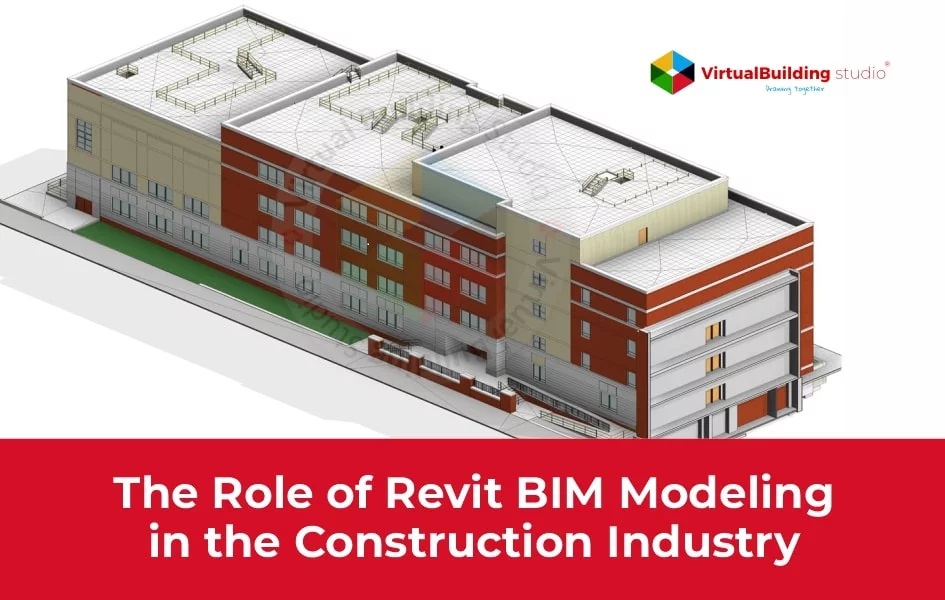The Role of Revit BIM Modeling in the Construction Industry

A realistic way of adding three-dimensional characteristics to a two-dimensional drawing is 3D Modeling. The Revit BIM Modeling is a major shift for the construction industry, from manual planning to digital visualization of spaces. Not only does the 3D model provide a detailed glance of how the project will look but also depicts the functional and technical aspects of the project as well.
Features like quality-driven and streamlined site work execution have made it a preferable choice for construction professionals lately, increasing its use tenfold.
BIM technology was developed four decades ago and is considered a crucial development for the industry. Architectural 3D Modeling Services are used in the construction industry to ensure a well-estimated and accurate version of the drawing is converted into a detailed digital model.
The construction professionals can refer to the model for project execution on site. The virtual design process allows simulations representing the interior and exterior look of the project. A single 3D model integrates multiple designs, facilitating construction, operation, and maintenance.
What is Revit BIM Modeling?
Revit BIM Modeling is a profound modeling technique serving the architectural, engineering, and construction sectors, significantly for the past few years. Revit is a design and visualization software that uses BIM technology to develop three-dimensional models of a structure.
The manual work is majorly reduced, saving a huge amount of time and money for the stakeholders and the client. Revit 3D modeling allows the designers to be more creative, indulge in complex designs, and transform ideas into actual structures into digital models, later replicated on the construction site.
Features of Revit that Simplify the 3D Modeling Process
Revit offers several features that serve as a facilitator for a better modeling process, hence enhancing the design and execution of the project. Here are the key features of Revit BIM modeling that simplifies the 3D modeling process:
Clash Avoidance Tools
These are the user-friendly tools that reduce the site rework by fixing the component location conflicts during the design phase.
Automatic Updates
Whatever the addition or change is made to any project component or phase, this feature updates all the changes automatically to the model.
Detailed Data Analysis
The information about every component is embedded in detail in the 3D Revit model, which enables interaction with other elements.
Multi-Monitor Support
Revit BIM modeling generates views of a building from various angles, and these views are organized in tabbed documents.
Multi-Monitor Support-insight
These documents can be docked, tiled, and displayed on multiple monitors to improvise and optimize spaces.
Fewer Information Requests
After the 3D model is developed, it is shared with other project stakeholders, who can easily make the edits. The users with access to the model are sent an alert about the changes, and all amendments are automatically updated.
Multiple Views
Revit BIM modeling provides multiple views of the building, perspective views of levels, sections, and an entire view of the model, which can be studied by the users using different commands.
Detailed Energy Analysis
The provision of various BIM Dimensions enables the assessment of various aspects of a structure like energy and environmental analysis. The 6D BIM can be used for energy analysis of a building.
Modification and Coordination Ease
The dimensions, specifications, conceptual layout, or elevational changes can be easily made to the model, further updating all drawings automatically. This facilitates a simplified collaboration and coordination process among the team members.
Benefits of Revit 3D Modeling Services in the Construction Industry
Revit has been used in the construction industry for years and has benefitted the industry in various ways. A few of the many benefits that this software has to offer are:
Enhanced Productivity
The consistent advancement of technology in the construction sector is reducing the turn-around time for the projects.
The 3D modeling enables fast-paced execution of a task, providing the architect with more construction time and less time investment in changes and rework. The time savage gradually increases the productivity of architects and designers.
Quality Design
Architectural 3D modeling provides a detailed three-dimensional perspective of the project. The intricacy and precision of these modeling services enhance the quality of the final design deliverable.
The AEC professionals incorporate Revit Modeling services in their projects for quality-driven, information-rich, and detail-oriented outcomes.
Automated Updates
When a change is made to a particular design element, it automatically gets applied throughout the model. This feature simplifies the documentation, and the modified design can be visualized in a better way.
Enhanced Coordination and Communication Between Client and Service Provider
Revit BIM Modeling uses a single central data source that has error-free and updated data. It increases the coordination between the project stakeholders and regulates communication associated with the project.
The amendments made to the design are conveyed further so that everyone is on the same page and shares aligned interests in the design.
Documenting the As-Built
For renovation or restoration projects, BIM modeling services facilitate the documentation of the as-built site conditions. The site details are captured as scanned point cloud data, which is then smoothly converted into a 3D model.
Architectural 3D modeling helps in capturing the exact nuances of the project and enables the surveyors to provide quality-driven data for further project execution.
Reduce On-Site Potential Risks
3D modeling services enable the architects to indulge in a detailed designing process, as the technology catalyzes the working with enhanced quality and reduced time investment.
Any design error or potential construction risks are detected and can be rectified in the initial design stage, eliminating the chances of failure during construction.
A Sustainable Process
With Revit BIM modeling, the project designing process doesn’t involve much paperwork. It eliminates the repetitive creation of drawings after any changes in the initial drawings as the database stores and incorporates all the information and amendments to the final drawings, made throughout the design process. Hence, adapting BIM modeling services is also a step towards sustainability.
Conclusion
Revit is a powerful design tool with applications in construction administration, facility management, operation, maintenance, building renovations, and refurbishments.
The company engaging with BIM modeling services can stay ahead in the AEC industry with its innovative solutions and complex design-creating capabilities. It helps the company gain a competitive edge and develop a significant brand identity.
Source: https://www.virtualbuildingstudio.com/revit-bim-modeling-in-construction/
+ Post an article












